Hola amigos! Tengan bonita noche, Dios les bendiga mucho, espero se encuentren bien y sanos. ♡
Hi friends! Have a nice night, God bless you very much, I hope you're well and healthy. ♡
Hace unos días, mi mamá me comentó que compraría una botella de miel para la casa, y luego de pensarlo, me di cuenta que en realidad es un muy buen tema del cual escribir.
A few days ago, my mom told me that she would buy a bottle of honey for the house, and after thinking about it, I realized that it is actually a very good topic to write about.
En lo personal, me encanta la miel, es decir, es increíble para tantas cosas... Postres, comidas, remedios caseros y hasta mascarillas faciales. Una de las cosas que hacía casi diariamente cuando había miel en mi casa, era tomar té con limón y miel, Dios, que cosa tan buena, además de que en realidad me gusta el té, me caía de maravilla.
Personally, I love honey, that is, it is incredible for so many things ... Desserts, meals, home remedies and even facial masks. One of the things that I did almost daily when there was honey in my house, was to drink tea with lemon and honey, God, what a good thing, besides that I actually like tea, That made me feel great.
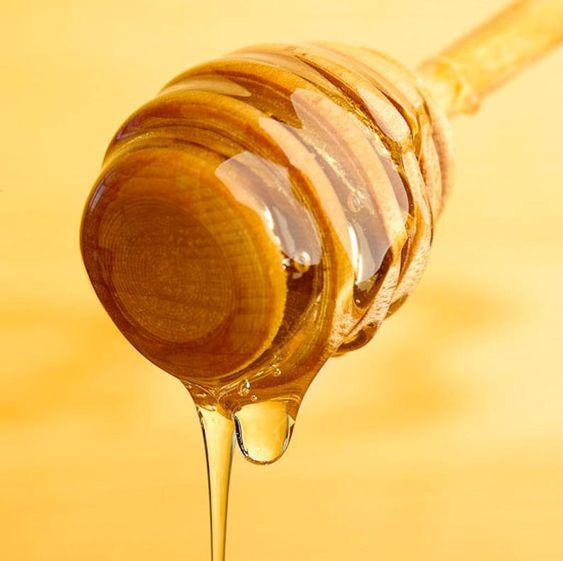
Fuente - Source
La miel es uno de los productos naturales más funcionales y ricos, es por esto que, al menos en donde vivo, su valor o precio es algo alto; pero, ¿Se han preguntado exactamente cómo se produce la miel? Sí, sabemos que la hacen las abejas con el néctar que recogen de las flores; pero quise averiguar el proceso un poco más a detalle para explicarles.
Honey is one of the most functional and rich natural products, which is why, at least where I live, its value or price is somewhat high; But, ¿Have you ever wondered exactly how honey is produced? Yes, we know that bees make it with the nectar they collect from flowers; but I wanted to find out the process a little more in detail to explain you.
Probablemente tenías la idea de que la preparación de la miel y la polinización estaban relacionadas, pero la realidad es que no, la polinizaición no tiene que ver con la miel, esta sólo es el proceso mediante el cual, las abejas transfieren el polen de una parte de la flor a otra, específicamente del estambre, que es el órgano masculino de la flor; al estigma, el órgano femenino de la misma; dando paso de esta manera a la producción de semillas y frutos, producto de la fecundación y germinación de óvulos en la flor. Esto no tiene que ver con la miel, pero sé que muchos de ustedes tal vez confundían ambos procesos pensando que eran lo mismo (como yo antes de investigar), y ahora ya saben que aunque ambos son hechos por las abejas, no se relacionan. Dicho esto, ahora sí voy con la explicación de la miel.
You probably had the idea that the preparation of honey and pollination were related, but the reality is that no, pollination doesn't have to do with honey, this is only the process by which bees transfer pollen from a part of the flower to another, specifically the stamen, which is the male organ of the flower; to the stigma, the female organ of the same; thus giving way to the production of seeds and fruits, product of the fertilization and germination of ovules in the flower. This has nothing to do with honey, but I know that many of you maybe confused both processes thinking that they were the same (as I did before researching), and now you know that although both are made by bees, they're not related. That said, now I do go with the explanation of honey.
Como sabemos, la miel es hecha por las abejas, pero algo que seguramente no sabías, es que las abejas tienen dos estómagos, uno propio para almacenar su comida y llevar a cabo sus procesos digestivos así como nosotros; y otro para el almacenamiento y producción de miel.
As we know, honey is made by bees, but something you probably didn't know is that bees have two stomachs, one of their own to store their food and carry out their digestive processes just like we do; and another for the storage and production of honey.
Sabemos que esto se trata de un trabajo en equipo. Las abejas visitan las flores, recolectando el néctar (un líquido azucarado), que hay en estas, ¿Cómo lo hacen? Lo succionan o chupan con sus lenguas, parecido a las mariposas jsjs. ¿Recuerdan que arriba les mencioné que tenían dos estómagos? Bueno, el de la miel les sirve para almacenar el néctar recolectado, así como una bolsita o saco. Cuando su saquito de néctar está completamente lleno, las abejas regresan a sus panales para comenzar la producción.
We know this is about teamwork. The bees visit the flowers, collecting the nectar (a sugary liquid), which is in them. ¿How do they do it? They suck it with their tongues, similar to butterflies, jsjs. ¿Remember I mentioned above that they have two stomachs? Well, honey stomach used to store the collected nectar, as well as a bag or sack. When their bag of nectar is completely full, the bees return to their combs to begin production.
Un dato es que, de este néctar que las abejas recolectan, si en algún momento tienen hambre, a través de una válvula que abren, pasan un poco de su estómago de miel, a su estómago propio para alimentarse y convertirlo en energía para sus necesidades propias; pero me fui un poco del tema sjsj, porque estamos hablando de la miel, no de las abejas...
One fact is that, from this nectar that the bees collect, if at some point they are hungry, through a valve that they open, they pass a little from their stomach of honey, to their own stomach to feed themselves and convert it into energy for their needs own; but I left the sjsj topic a bit, because we are talking about honey, not bees...
Una vez en la colmena, pasan el néctar por su boca a las otras abejas (obreras). Estas lo mastican por media hora aproximadamente, o al menos hasta que la humedad en este se reduzca más o menos de un 70% a un 20%. Luego de esto, nuevamente se pasa de abeja en abeja hasta el punto en que, de forma gradual, este néctar se convierte en miel. Luego de todo esto, las abejas guardan la miel en celdas de panal (los hexágonos amarillos que vemos seguido cuando se habla de miel), que digamos son "frascos pequeños" hechos de cera.
Once in the hive, they pass the nectar through their mouths to the other bees (workers). They chew it for about half an hour, or at least until the humidity in it is reduced more or less from 70% to 20%. After this, it again passes from bee to bee to the point where, gradually, this nectar turns into honey. After all this, the bees keep the honey in honeycomb cells (the yellow hexagons that we see often when talking about honey), wich we could say are "small jars" made of wax.
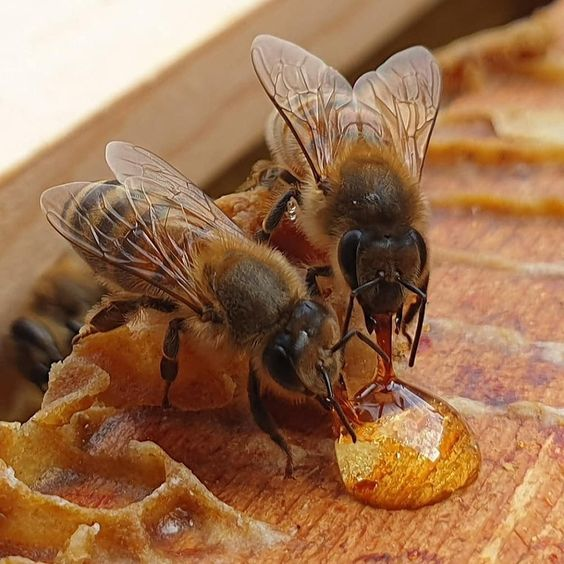
Fuente - Source
Es un proceso realmente fascinante y es increíble que unos animalitos tan pequeños hagan tanto, siento que son más productivos que yo jsjs... Tranquilo, si te quedaste pensando en que las abejas hacen todo esto con sus bocas (y seguro que sí), te hago la aclaratoria para que puedas dormir en paz, de que ellas son muy limpias. Literalmente luego de terminar todo este trabajo, las abejas se limpian y peinan, es decir, cuidan de sí mismas porque eso también les ayuda a trabajar de manera más eficiente, así que por esa parte, puedes descansar... Otra cosa es que, como la miel, luego del todo el proceso que ya les expliqué, aún está un tanto húmeda, las abejas usan sus alas a modo de ventilador para que esta se seque y adquiera esa textura pegajosa. Por último, sellan las celdas en donde habían guardado la miel para que se mantenga limpia; así que sí, las abejas son más limpias y organizadas que muchos de nosotros y es un proceso 100% hipoalergénico y puro xd.
It's a really fascinating process and it's incredible that such small animals do so much, I feel that they're more productive than me jsjs ... Don't worry, if you're thinking to much that bees do all this with their mouths (and they sure do), I will clarify for you so that you can sleep in peace jsjs, that they're very clean. Literally after finishing all this work, the bees clean and comb themselves, that is, they take care of themselves because that also helps them work more efficiently, so for that part, you can rest ... Another thing is that, Like honey, after the whole process that I explained to you, it's still a bit wet; the bees use their wings as a fan so that it dries and acquires that sticky texture. Finally, they seal the cells where they had kept the honey so that it stays clean; so yeah, bees are cleaner and more organized than many of us and it's a 100% hypoallergenic and pure process xd.
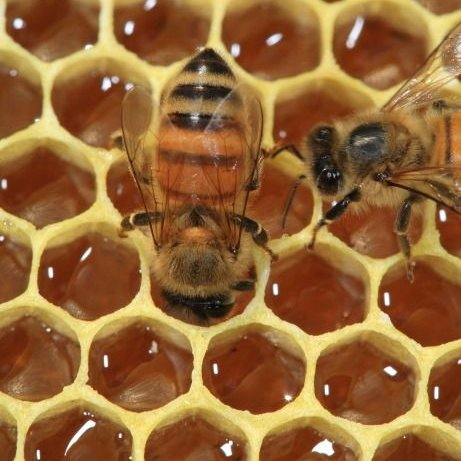
Fuente - Source
Otro dato curioso: Para hacer apenas una cuchara de miel se necesitan unas ocho abejas, ahora piensen cuántas se necesitarían para hacer un litro... Para nuestra fortuna, las abejas suelen hacer más de la que ellas mismas necesitan. Es simplemente deslumbrante.
Another curious fact: To make just one spoon of honey you need about eight bees, now think about how many it would take to make a liter... Fortunately for us, bees usually make more than they need. It's simply stunning.
Casi a punto de despedirme, les cuento que, uno de mis usos favoritos de la miel es para endulzar tés. El té con miel y limón, ayuda para la garganta; si están roncos, con un resfriado o con un malestar en la garganta, este té es maravilloso para ello, incluso pueden agregarle jengibre si prefieren. Sin mencionar que endulzar los tés con miel es más sano que hacerlo con azúcar.
Almost about to say goodbye, I tell you that one of my favorite uses of honey is to sweeten teas. The tea with honey and lemon, helps for the throat; if you are hoarse, have a cold or a sore throat, this tea is wonderful for it, you can even add ginger if you prefer. Not to mention, sweetening teas with honey is healthier than sweetening it with sugar.
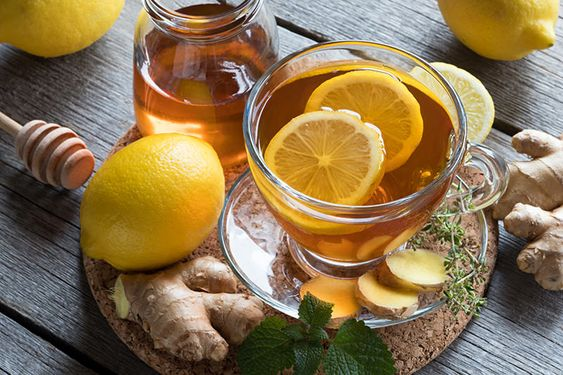
Fuente - Source
Ahora sí, fue todo por hoy! Espero les haya gustado y servido mucho este blog... Es de mis favoritos, para ser honesta jsjs. La recomendación del día de hoy es "Honey" by Johnny Balik, la pueden encontrar en Youtube y Spotify de manera oficial. Descansen, hasta la próxima! ♡
Now yes, it was all for today! I hope you liked and served this blog a lot ... It is one of my favorites, to be honest jsjs. Today's recommendation is "Honey" by Johnny Balik, you can find it on YouTube and Spotify officially. Rest up, til next time! ♡
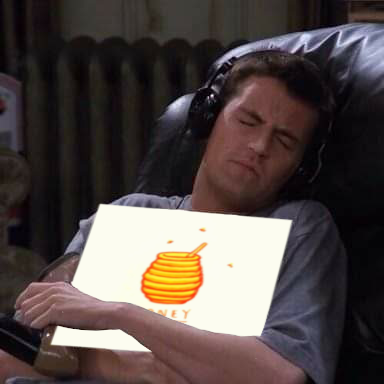
Originally posted here: https://hive.blog/hive-148441/@annie-jjk/esp-eng-life-is-sweet-as-honey
No comments:
Post a Comment